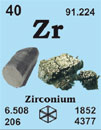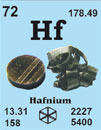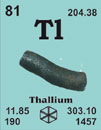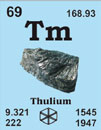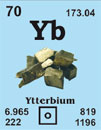Vanadium 73V50.942
Vanadium was discovered in 1801 by A.M. del Rio at Mexico City, Mexico. Rediscovered in 1831 by N.G. Selfström at Falun, Sweden.
[Named after Vanadis, a Scandianavian goddess]
French: vanadium
German: Vanadium
Italian: vanadio
Spanish: vanadio
Description: Vanadium is a shiny, silvery metal, which is soft when pure. It resists corrosion due to a protective film of oxide on the surface. Vanadium is attacked by concentrated acids, but not alkalis, not even when these are molten. The metal is used mainly as alloys, especially in steels.
Vanadium single crystal properties
| State: |
single crystal |
|---|
| Crystal structure: |
bcc |
|---|
| Production method: |
Floating zone |
|---|
| Standard size: |
diameter 12mm
thickness 1-2mm |
|---|
| Orientation: |
(100), (110) and (111) |
|---|
| Orientation accuracy: |
<2°, <1°, <0.4° or <0.1° |
|---|
| Polishing: |
as cut, one or two sides polished |
|---|
| Roughness of surface: |
<0.03µm |
|---|
| Purity: |
99.99% |
|---|
| Typical analysis (ppm): |
C 3
H < 1
O 9
N < 5
Cu 1.60
Fe 1.80
Ni < 1
Pb 0.30
Si 0.30
Ga, Hf and Ta are below the detection limit
|
|---|
Materials properties
| Density: |
6.1 g/cm3 |
|---|
| Melting point: |
1886.85 °C / 2160 °K |
|---|
| Boiling point: |
3376.85 °C / 3650 °K |
|---|
| Molar volume: |
8.34 cm3 |
|---|
| Thermal conductivity: |
30.7 [300 K] Wm-1K-1 |
|---|
| Coefficient of linear thermal expansion: |
8.3 x 10-6 K-1 |
|---|
| Electrical resistivity: |
24.8x 10-8 [293 K] Wm |
|---|
| Mass magnetic susceptibility: |
+6.28 x 10-8(s) kg-1m3 |
|---|
| Young's modulus: |
127.6 GPa |
|---|
| Rigidity modulus: |
46.7 GPa |
|---|
| Bulk modulus: |
158 GPa |
|---|
| Poisson's ratio: |
0.365 |
|---|
| Radii: |
V5+ 59; V4+ 61; V3+ 65; V2+ 72; atomic 132 |
|---|
| Electronegativity: |
1.63 (Pauling); 1.45 (Allred); 3.6 eV (absolute) |
|---|
| Effective nuclear charge: |
3.30 (Slater); 4.98 (Clementi); 6.65 (Froese-Fischer) |
|---|
| Number of Isotopes (incl. nuclear isomers): |
11 |
|---|
| Issotope mass range: |
44 -> 55 |
|---|
| Crystal structure, (cell dimentions / pm), space group |
bcc |
|---|
| X-ray diffraction: mass absorption coefficients: |
CuKα 233 (µ/r) / cm2g-1
MoKα 27.5 (µ/r) / cm2g-1 |
|---|
| Neutron scattering length: |
-0.0382 b/10-12 cm |
|---|
| Thermal neutron capture cross-section: |
5.08 sa / barns |
|---|
Biological data
| Biological role: |
Essential to some species including humans; it also acts to stimulate metalbolism. |
|---|
| Toxicity |
|
|---|
| Toxic intake: |
toxicity varies |
|---|
| Lethal intake: |
LD50 (V2O5, oral, rat) = 10 mg kg-1 |
|---|
| Hazards: |
Vanadium and its compunds irritate the eyes and lungs; the fumes of volatile compounds are highly toxic. Some vanadium compounds have experimental mutagenic effects. |
|---|
| Level in humans |
|
|---|
| Blood: |
<0.0002 mg dm-3 |
|---|
| Bone: |
0.0035 p.p.m. |
|---|
| Liver: |
0.006 p.p.m. |
|---|
| Muscle: |
0.02 p.p.m. |
|---|
| Daily dietary intake: |
0.04 mg |
|---|
| Total mass of element in average [70 kg] person: |
0.11 mg |
|---|
Geological data
| Mineral | Formula | Density | Hardness | Crystal apperance |
|---|
| Carnotite |
K2(UO2)2(VO4)2.3H2O |
4.95 |
n.a. |
mon., dull/earthy/pearly yellow |
|---|
| Descloizite |
PbZn(VO4)(OH) |
6.2 |
3 - 3.5 |
orth., greasy brown/red |
|---|
| Patrónite |
VS4 |
2.81 |
2 |
mon., grey-black |
|---|
| Vanadinite |
Pb5(VO4)3Cl |
6.86 |
2.7 - 3 |
hex., sub-res./sub-adam. orange red |
|---|
| Chief ore: |
descloizite, patronite, vanadite, carnotite. |
|---|
| World production: |
7000 tonnes/year |
|---|
| Main mining areas: |
not mined as such, but generally obtained as a by-product of other ores and from Venezuelan oils. |
|---|
| Reserves: |
n.a. |
|---|
| Specimen: |
available as foil, granules, powder, rod or turnings. CARE ! |
|---|
| Abundances |
|
|---|
| Sun: |
1.05 x 104 (relative to H = 1 x 1012) |
|---|
| Earth's crust: |
160 p.p.m. |
|---|
| Seawater: |
|
|---|
| Residence time: |
|
|---|
| Classification: |
recycled |
|---|
| Oxidation state: |
V |
|---|
Source: Emsley, J. (1998) The Elements (3rd Edition)

 English
English
 Deutsch
Deutsch








































